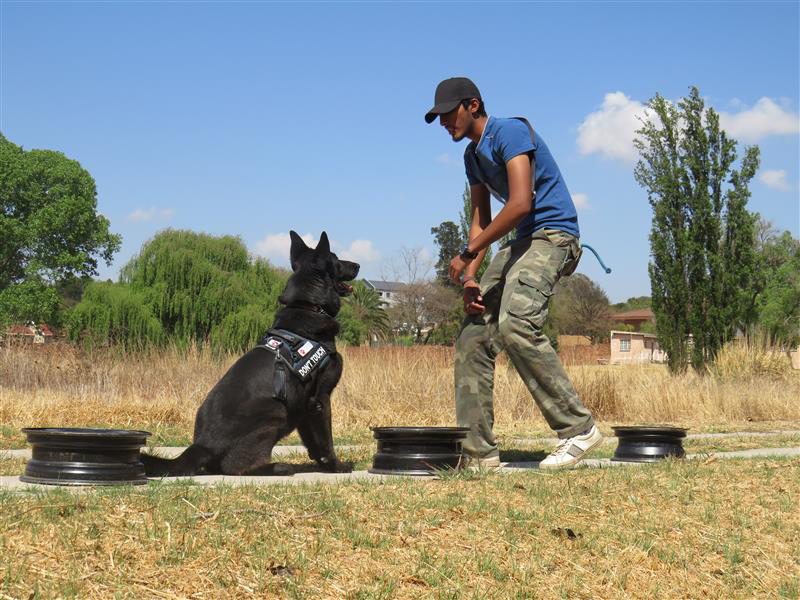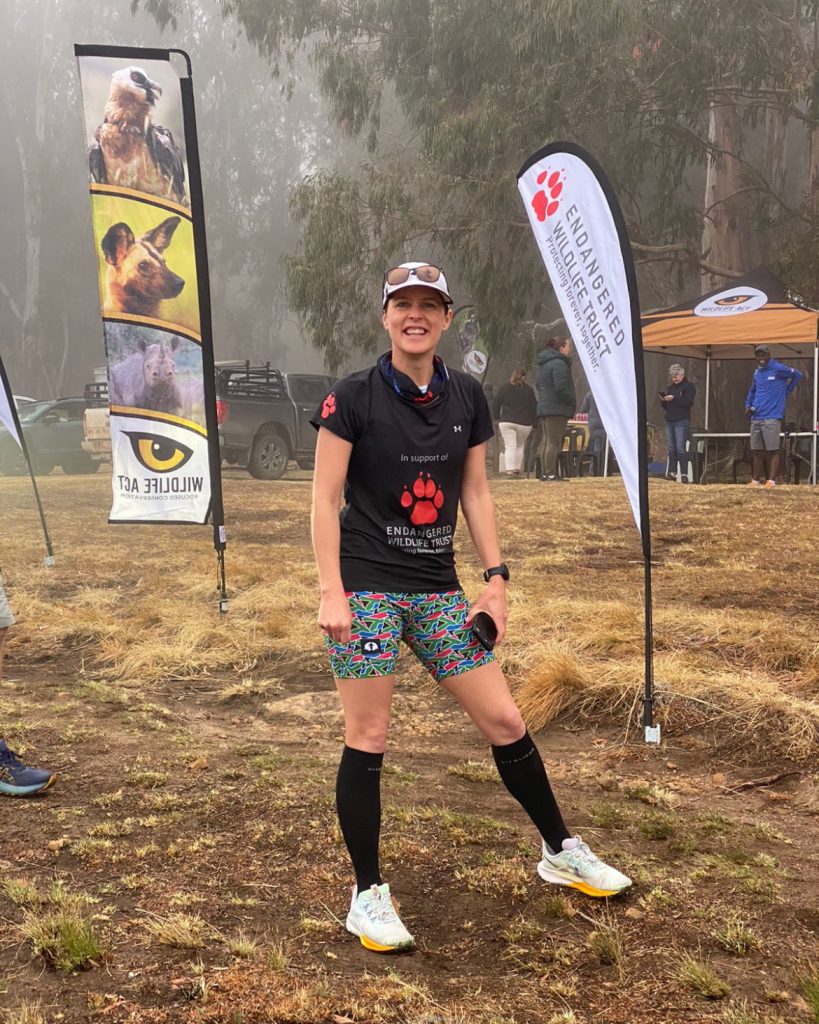10 Years Foundation
Protecting Wildlife in South Africa
Endangered Wildlife Trust and DERTOUR Foundation’s Joint Conservation Efforts
As the DERTOUR Foundation reaches the remarkable milestone of a decade of impactful collaborations, we are thrilled to shine a spotlight on our valued partners. Today, we celebrate the remarkable work of the Endangered Wildlife Trust (EWT), one of the largest and most respected biodiversity conservation NGOs in southern Africa.

EWT’s Pioneering Efforts in Wildlife Conservation
Since its inception in 1973, the EWT has continually expanded its efforts
to protect ecosystems and species across Southern and East Africa. Their
mission is to safeguard wildlife for the benefit of animals, people, and
nature alike.
A key aspect of EWT’s strategy is the deployment of conservation canines. These specially trained dogs have proven to be essential in combating poaching. With support from the DERTOUR Foundation, EWT has enhanced this program, funding a dog handler, a sniffer dog, and a tracking dog, along with their medical care.

Since its inception in 1973, the EWT has continually expanded its efforts to protect ecosystems and species across Southern and East Africa. Their mission is to safeguard wildlife for the benefit of animals, people, and nature alike.
A key aspect of EWT’s strategy is the deployment of conservation canines. These specially trained dogs have proven to be essential in combating poaching. With support from the DERTOUR Foundation, EWT has enhanced this program, funding a dog handler, a sniffer dog, and a tracking dog, along with their medical care.

The Role of Conservation Canines
The Pilanesberg Nature Reserve, set around an extinct volcano, is home to a diverse array of wildlife, including the iconic Big Five: elephants, rhinos, lions, leopards, and buffalo. However, this sanctuary faces constant threats from poachers seeking to exploit its natural resources. Conservation canines have become vital in this fight.
These dogs, with their extraordinary sense of smell, are trained to detect a variety of contraband, from rhino horn and ivory to firearms and ammunition. On any given day, they can be seen alongside their handlers, checking vehicles and patrolling the park’s boundaries. Despite the challenging terrain and heavy traffic, these teams work diligently to counteract poaching activities.
A Day in the Life of a Conservation Canine
A typical day for a sniffer dog at Pilanesberg starts early. As the sun rises, the handler and their canine partner set out for a day of patrol. The dog, nose to the ground, is focused on detecting potential threats, from wildlife contraband to illegal arms. Every successful detection is a step towards preserving the park’s ecosystem.
These dogs are more than just tools; they are partners. Handlers like Clyantha and Fudhail have developed strong bonds with their canine companions, ensuring their well-being and motivation. The dogs are trained with play as a reward, maintaining their enthusiasm and effectiveness.
New Challenges, New Solutions:
Interview with Tammy Baker, Business
Development Officer at EWT
EWT recently celebrated its 50th anniversary. What has been the impact of the conservation efforts over the years?
Tammy Baker: Celebrating 50 years of conservation is a significant milestone for us. Over the years, our efforts have made a considerable impact, particularly in curbing poaching activities and protecting
endangered species. Our conservation canine unit, established in 2012, has been crucial in this regard. These dogs support anti-poaching initiatives on game reserves and help detect wildlife contraband before it leaves the country. This approach has allowed us to respond effectively to various threats.

New Challenges, New Solutions:
Interview with Tammy Baker, Business
Development Officer at EWT

EWT recently celebrated its 50th anniversary. What has been the impact of
the conservation efforts over the years?
Tammy Baker: Celebrating 50 years of conservation is a significant milestone for us. Over the years, our efforts have made a considerable impact, particularly in curbing poaching activities and protecting
endangered species. Our conservation canine unit, established in 2012, has been crucial in this regard. These dogs support anti-poaching initiatives on game reserves and help detect wildlife contraband before it leaves the country. This approach has allowed us to respond effectively to various threats.
Can you tell us more about the role of the conservation canines in EWT’s initiatives?
Tammy Baker: Our conservation canines are invaluable. Each dog is trained to either track poachers or detect contraband, and sometimes both. The dogs operate with their handlers, conducting vehicle searches and patrols. The partnership with DERTOUR Foundation has enabled us to place these canine units in critical areas where poaching is rampant. The handlers and dogs form a strong bond, ensuring that the dogs’ well-being is always a priority.
How do the dogs contribute to preventing poaching, particularly in challenging environments like the Pilanesberg Nature Reserve?
Tammy Baker: The Pilanesberg Nature Reserve is a challenging environment due to its vast area and difficult terrain. However, our dogs are trained to handle such conditions. They can detect minute traces of wildlife products and track poachers across the reserve. The presence of these dogs acts as a significant deterrent to poachers, knowing that their chances of being caught are much higher.
What new threats are emerging, and how is EWT adapting its strategies to tackle them?
Tammy Baker: One of the emerging threats we’ve identified is the poaching of succulents, particularly Karoo succulent plants. In response, we’ve started training our detection dogs to identify these plants. Additionally, we are exploring the use of dogs to locate wire snares more efficiently. We have trialled the concept in the field and set up a repeatable experiment, comparing the efficiency of rangers working by themselves, with rangers working in a team with canines and handler. The rangers identified between 10%-20% of placed snares and articles, while the dog and handler team accompanied by rangers found between 50%-100% of snares and articles placed during the experiment. The articles are bottles, cans, rags etc, anything with human scent. This adaptability in our strategies ensures that we stay ahead of poachers and protect a broader range of species and ecosystems.
What makes working with detection and tracking dogs special for you and the team?
Tammy Baker: Working with detection and tracking dogs is incredibly rewarding. These dogs are highly skilled and show visible joy when they successfully indicate on a target scent. Their different working styles, from frantic searches to slow and meticulous checks, are fascinating to watch. The bond between the handlers and the dogs is also remarkable, as they spend every day together, training and ensuring each other’s safety. This partnership is crucial for the success of our conservation efforts.
The collaboration between the DERTOUR Foundation and EWT showcases how strategic partnerships and innovative approaches can significantly impact wildlife conservation. Through the use of highly trained conservation canines, EWT continues to lead the fight against poaching, ensuring the protection of endangered species and their habitats. By leveraging the skills of highly trained conservation canines and their dedicated handlers, this alliance has made significant strides in combating poaching and protecting endangered species.
